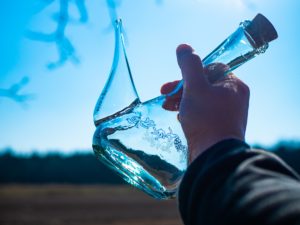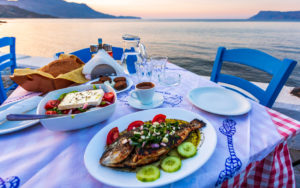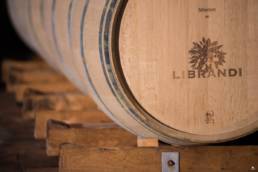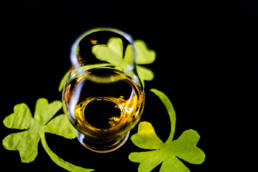FMN – November 2022 – Fishing for Some Wines
When the weather turns a bit cooler, I find myself trying to get to the “low country” as much as I can. My reasoning for making a beeline to this amazing part of South Carolina are multifold. I love the view of the sun over the marsh grass, the smell of the salt air, and the promise of catching my dinner, with the benevolence of the fishing gods.
In-shore fishing, in this part of the country, can provide one with some succulent rewards. There is opportunity for spotted trout, redfish (spot tail bass), begging to be blackened pan seared, or even some flounder that may feel the need to sacrifice for the “greater good.” Whatever fish happenstance provides us, we will need some beverages to wet our proverbial whistles while filling our gobs with the treasures of the ocean.
There are many countries and cultures that have historically seen their seafood fare and their wine grow up together. Although there is a plethora of examples, and I could write an entire book on food and pairings for ocean critters, I have my available-to-me-at-this-time favorites that I will share with you.
When thinking of pairing French wine with seafood, Muscadet instantly comes to mind. The region is located as far west in Loire Valley that you can get and still keep your feet dry. Centered around the town of Nantais, the area encompassing all the Muscadet appellations is huge, over 8000ha (about 20,000 acres). Although styles and grape varieties vary slightly, the main grape is Melon de Bourgogne.
This white variety carries this name due to its origins in the Burgundy region, where it was banished multiple times (along with Gamay) only to find a new home in the western reaches of the Loire. These grapes, and subsequent wines, thrived in this Loire region, today demonstrating one of the best pairings with ocean mollusks that you will ever experience. One reason for such a benevolent partnership with seafood comes from an almost saline-like acidity that can remind one of fresh ocean spray on the lips. In addition, when the wines are aged sur lie (on the lees or expired yeast), these wines gain body (mouth-feel), along with additional aromas and flavors from the yeast themselves. This wine remains one of my favorite non-sparkling pairings with oysters; an absolute must try.
Spain has a number of regions that produce wines with an affinity for their respective fresh local seafood. My go-to has long been Albariño for these dishes but playing it safe is no way to live your life. For this reason, we will be adventurous with some white Txakoli (sha-kol-ee) from the Basque region of Spain.
Straddling the border of both Spain and France, these wines stem from a culture, and language, older than both these countries. Hondarrabi Zuri is the main white variety here, although it has been questioned if it is indeed a grape at all or rather a field blend of mixed varieties. Nonetheless, the white wines produced here are a proverbial heaven for your acidophilic wine gluttons. Their palate cleansing nature comes not only from their bright acidity but also due to the existence of petillance (lazy bubbles). These wines are best enjoyed pouring directly from the traditional porron (glass pitcher with a narrow spout) into your gaping open wine hole, but it is completely acceptable to use a wine glass.
white variety here, although it has been questioned if it is indeed a grape at all or rather a field blend of mixed varieties. Nonetheless, the white wines produced here are a proverbial heaven for your acidophilic wine gluttons. Their palate cleansing nature comes not only from their bright acidity but also due to the existence of petillance (lazy bubbles). These wines are best enjoyed pouring directly from the traditional porron (glass pitcher with a narrow spout) into your gaping open wine hole, but it is completely acceptable to use a wine glass.
Another country that has both and ancient wine history and an almost unrivaled seafood culture is Greece. With over 300 indigenous grape varieties grown among the 227 islands, you can see how the pairing opportunities become quite numerous. What truly simplifies (or limits) our choices comes down to availability of these wines in our domestic market. This scarcity comes from the sad fact that these wines, except among those with Greek heritage, just do not fly off the shelves. In truth, the sales of Greek wine in this country are flatter than my singing voice.
 Luckily, the Greek population is very culturally loyal when it comes to both food and wine so you can occasionally find these on the shelves to not only accompany your vast array of ocean dwelling goodies but also (red wines) for your lamb dishes as well. Unfortunately, many distributers fail to take the time to educate the consumer about these wines, opting for the effortless sales of the proverbial “low hanging fruit”; pun intended.
Luckily, the Greek population is very culturally loyal when it comes to both food and wine so you can occasionally find these on the shelves to not only accompany your vast array of ocean dwelling goodies but also (red wines) for your lamb dishes as well. Unfortunately, many distributers fail to take the time to educate the consumer about these wines, opting for the effortless sales of the proverbial “low hanging fruit”; pun intended.
I hope these options assist you in putting some wines on the table alongside the bounty you harvested from the sea. They do call it fishing and not catching. So, if your excursion turns out like mine with nothing more then a few teasing nibbles, there is always your local seafood market to the rescue. With any luck, it resides on the way to or from your local wine store.
Suggested Wines:
Sauvion Muscadet Sevre-et-Maine 2020 Loire Valley, France $16.99
The wine demonstrates aromas of ripe green apple, citrus curd, and a wet stone element. The palate is dry with bright Sauvignon Blanc like acidity with an added element of brine. The body has a slightly creamy texture, and the alcohol, checking in at 12%, only encourages us more. There are flavors of tree fruit (green apple), citrus (tangerine and lime) with a touch of brine and flinty minerality. Pair this wine with oysters or clams on the half shell or lighter grilled fishes.
Masua Txakoli 2020 Basque Country, Spain $15.99
This Basque wine is a blend containing 80% Hondarrabi Zuri, 20% Petit Courbu. Initially, I had to let the wine aerate due to a hint of sulfur but it blew off quickly. The complex nose has aromas of apple, nectarine, wet hay and celery leaf. The palate is dry with an upfront persistent citrus-laden acidity and a medium but slightly viscous body. The alcohol is well in balance at 12.5%, more guilt free-drinking. The palate is dominated by citrus flavors (grapefruit, tangerine, lemon) with a slight mineral and herbal note. Pair with ceviche seafood pinchos (white anchovies, sardines), or crab salad.
Domaine Sigalas ‘AM’ Assyrtiko / Monemvasia PGI Cyclades Santorini and Paros, Greece $25.99
This blend of two unique indigenous varieties (Assyrtiko from Santorini and Monemvasia from Paros), are great blending partners. The nose has aromas of fruit compote (pear, quince, apricot), smoky salted melon rind, and a slight white pepper note. The palate is dry with persistent linear acidity and a viscosity attributable to the Monemvasia. There are flavors that resemble the nose with an additional volcanic brined minerality and an almost viognier-like perfumed note on the finish. Pair with halloumi cheese, grilled seafood (whole fish, lobster) or fried calamari.



